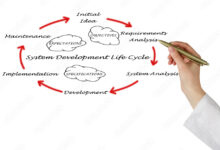System Development Life Cycle: 7 Powerful Stages Revealed
Ever wondered how complex software systems come to life? It all starts with a structured journey known as the system development life cycle. This proven framework guides teams from idea to implementation—and beyond.
What Is the System Development Life Cycle?

The system development life cycle (SDLC) is a comprehensive framework used to design, develop, test, and deploy information systems efficiently. It provides a structured approach that ensures quality, reduces risks, and keeps projects on track—both in time and budget. Originally developed for software engineering, SDLC has evolved to support various types of system development, including enterprise applications, cloud platforms, and embedded systems.
Core Definition and Purpose
At its heart, the system development life cycle is a methodology that breaks down the process of building a system into manageable phases. Each phase has specific goals, deliverables, and checkpoints. The primary purpose of SDLC is to produce high-quality systems that meet or exceed user expectations, are completed within time and cost estimates, and are easy to modify and maintain.
- Ensures structured planning and execution
- Facilitates clear communication among stakeholders
- Reduces project risks through early detection of issues
By following a defined path, organizations avoid chaotic development cycles and costly rework. The system development life cycle acts as a roadmap, guiding developers, project managers, and business analysts through every stage—from concept to retirement.
Historical Evolution of SDLC
The concept of the system development life cycle emerged in the 1960s during the rise of mainframe computing. As businesses began relying on large-scale data processing systems, there was a growing need for standardized development practices. Early versions of SDLC were heavily documentation-driven and followed a rigid, linear approach—what we now call the Waterfall model.
Over the decades, SDLC evolved in response to technological advances and changing business needs. The 1980s introduced iterative models, allowing for incremental development. In the 1990s, rapid application development (RAD) emphasized speed and user feedback. The 2000s brought Agile methodologies into the spotlight, promoting flexibility, collaboration, and continuous delivery.
Today, the system development life cycle is not a one-size-fits-all model. Organizations choose or adapt SDLC frameworks based on project scope, team size, regulatory requirements, and technological complexity. You can learn more about the history of software development from authoritative sources like Computer History Museum.
“The system development life cycle is not just a technical process—it’s a strategic enabler for aligning IT with business goals.” — Dr. James Cadigan, Systems Engineering Expert
The 7 Key Stages of the System Development Life Cycle
While variations exist across methodologies, most implementations of the system development life cycle consist of seven core stages. These stages provide a logical flow that ensures thorough planning, execution, and evaluation. Skipping or rushing through any of these phases can lead to project failure, budget overruns, or unsatisfied users.
1. Planning and Requirement Analysis
This is the foundation of the entire system development life cycle. During this phase, stakeholders—including clients, end-users, project managers, and developers—collaborate to define the project’s objectives, scope, and requirements. The goal is to answer critical questions: What problem are we solving? Who will use the system? What features are essential?
A detailed requirement specification document is produced, outlining functional requirements (what the system should do) and non-functional requirements (performance, security, scalability). Techniques like interviews, surveys, and use case modeling are commonly used.
- Identify business objectives
- Conduct feasibility studies (technical, economic, operational)
- Define system boundaries and constraints
This stage sets the tone for the entire project. Poorly defined requirements are one of the leading causes of project failure. According to the Standish Group, over 50% of failed IT projects cite incomplete or unclear requirements as a primary factor.
2. System Design
Once requirements are gathered and approved, the next stage in the system development life cycle is system design. This phase transforms user needs into a technical blueprint. Designers create architectural diagrams, data models, interface mockups, and process flows that guide the development team.
There are two main types of design: high-level (or architectural) design and detailed (or low-level) design. High-level design defines the overall system structure, including modules, components, and their interactions. Detailed design dives into specifics such as database schemas, API contracts, and algorithm logic.
- Create system architecture diagrams
- Design user interface (UI) and user experience (UX)
- Specify technology stack and integration points
The output of this phase is a System Design Specification (SDS) document, which serves as a reference throughout development. Tools like UML (Unified Modeling Language) and ER diagrams are widely used. For more on system design best practices, visit UML Diagrams.
3. Implementation (or Coding)
This is where the actual building begins. Developers write code based on the design specifications. The implementation phase is often the longest and most resource-intensive part of the system development life cycle. It involves programming, database setup, and integration of third-party services.
Modern development environments use Integrated Development Environments (IDEs), version control systems (like Git), and automated build tools to streamline coding. Teams may follow coding standards, conduct peer reviews, and use static analysis tools to ensure code quality.
- Write source code using selected programming languages
- Set up databases and configure servers
- Integrate external APIs and libraries
In Agile SDLC models, implementation happens in sprints, with working software delivered incrementally. This allows for early feedback and reduces the risk of building the wrong product.
4. Testing
No system is ready for deployment without rigorous testing. This phase ensures that the software meets the specified requirements and is free of critical bugs. Testing is not a single activity but a series of processes that include unit testing, integration testing, system testing, and user acceptance testing (UAT).
Testers use both manual and automated methods. Automated testing frameworks like Selenium, JUnit, and Postman help speed up the process and improve coverage. Defects are logged, prioritized, and fixed in collaboration with developers.
- Perform functional and non-functional testing
- Validate security, performance, and usability
- Ensure compliance with industry standards
A well-tested system significantly reduces post-deployment issues. According to IBM, fixing a bug after release can cost up to 100 times more than catching it during the design phase. Learn more about software testing at Software Testing Help.
5. Deployment
Once testing is complete and the system is approved, it’s time for deployment. This stage involves installing the system in the production environment and making it available to end-users. Deployment strategies vary depending on the project—options include big bang (full rollout), phased (gradual release), parallel (running old and new systems together), and pilot (limited user group).
DevOps practices have revolutionized deployment by enabling continuous integration and continuous deployment (CI/CD). Tools like Jenkins, Docker, and Kubernetes automate the deployment pipeline, reducing human error and accelerating delivery.
- Prepare production environment
- Migrate data from legacy systems
- Train end-users and support staff
Successful deployment doesn’t mean the job is done. Monitoring begins immediately to detect any issues in real-time.
6. Operation and Maintenance
After deployment, the system enters the operation phase. This is often the longest stage in the system development life cycle. The system is actively used, and the IT team ensures it runs smoothly. Maintenance includes fixing bugs, applying patches, optimizing performance, and addressing user feedback.
Maintenance is categorized into four types: corrective (fixing defects), adaptive (adjusting to new environments), perfective (improving functionality), and preventive (avoiding future issues). Regular updates keep the system secure and relevant.
- Monitor system performance and uptime
- Respond to user support tickets
- Apply security updates and patches
Effective maintenance extends the system’s lifespan and ensures continued value to the organization.
7. System Retirement
Every system has a lifecycle. Eventually, it becomes outdated, too costly to maintain, or no longer meets business needs. The final stage of the system development life cycle is retirement. This involves decommissioning the system, migrating data to a new platform, and informing stakeholders.
Retirement must be handled carefully to avoid data loss or business disruption. A formal retirement plan includes data archiving, user notification, and documentation of lessons learned.
- Plan for data migration or archival
- Decommission servers and licenses
- Conduct post-mortem analysis
Even in retirement, the system development life cycle teaches valuable lessons that inform future projects.
Popular SDLC Models and Methodologies
The system development life cycle is not tied to a single methodology. Different models offer varying levels of flexibility, control, and speed. Choosing the right model depends on project requirements, team structure, and organizational culture.
Waterfall Model
The Waterfall model is the oldest and most traditional approach to the system development life cycle. It follows a linear, sequential flow where each phase must be completed before the next begins. This model works well for projects with clearly defined requirements and minimal expected changes.
- Simple and easy to understand
- Clear milestones and deliverables
- Well-suited for regulated industries (e.g., healthcare, aerospace)
However, its rigidity is a major drawback. Once a phase is completed, going back is difficult and costly. For more on Waterfall, see GeeksforGeeks.
Agile Model
The Agile model is one of the most popular approaches in modern software development. It emphasizes iterative development, customer collaboration, and responsiveness to change. Instead of delivering the entire system at once, Agile breaks the project into small increments called sprints, typically lasting 2–4 weeks.
- Promotes continuous feedback
- Enables rapid adaptation to changing requirements
- Improves team morale and productivity
Frameworks like Scrum and Kanban are commonly used within Agile. While highly effective, Agile requires strong communication and disciplined team practices.
Iterative and Incremental Model
This model combines elements of both Waterfall and Agile. Development occurs in cycles (iterations), with each cycle producing a working version of the system. After each iteration, feedback is gathered, and improvements are made in the next cycle.
- Reduces project risk by delivering early prototypes
- Allows for gradual refinement of requirements
- Supports parallel development of modules
It’s ideal for large projects where the full scope isn’t known upfront.
Benefits of Following the System Development Life Cycle
Adopting a structured system development life cycle offers numerous advantages for organizations, development teams, and end-users alike. It transforms chaotic, unpredictable projects into controlled, measurable processes.
Improved Project Management
SDLC provides a clear framework for planning, scheduling, and tracking progress. Project managers can set realistic timelines, allocate resources efficiently, and monitor milestones. This transparency helps in identifying delays early and taking corrective actions.
- Clear accountability at each stage
- Better budget forecasting
- Enhanced stakeholder communication
With SDLC, project overruns become less frequent, and success rates improve significantly.
Higher Quality Deliverables
By enforcing rigorous testing, documentation, and review processes, the system development life cycle ensures that the final product is robust, secure, and user-friendly. Quality assurance is built into every phase, not added as an afterthought.
- Reduced number of post-release bugs
- Consistent adherence to coding and design standards
- Improved system reliability and performance
High-quality systems lead to greater user satisfaction and lower maintenance costs.
Risk Mitigation and Compliance
SDLC helps identify potential risks early—whether technical, financial, or operational. Risk assessment is a formal part of the planning and design phases. Additionally, many industries require compliance with standards like ISO/IEC 12207, HIPAA, or GDPR, which SDLC supports through documentation and audit trails.
- Early detection of feasibility issues
- Regulatory compliance through structured processes
- Disaster recovery and backup planning
Organizations in finance, healthcare, and government sectors rely heavily on SDLC for compliance and security.
Challenges and Common Pitfalls in SDLC
Despite its benefits, the system development life cycle is not without challenges. Misapplication, lack of stakeholder involvement, or poor planning can undermine even the best-intentioned projects.
Changing Requirements
One of the biggest challenges in the system development life cycle is managing changing requirements. In dynamic business environments, user needs evolve rapidly. Traditional models like Waterfall struggle with this, while Agile handles change more gracefully.
- Scope creep can lead to delays and budget overruns
- Lack of flexibility in rigid models
- Difficulty in maintaining documentation with frequent changes
Solution: Use hybrid models or adopt Agile practices to accommodate change without losing control.
Poor Stakeholder Communication
When stakeholders—especially end-users—are not involved throughout the system development life cycle, the final product may fail to meet their needs. Miscommunication leads to incorrect assumptions and mismatched expectations.
- Users feel disconnected from the development process
- Feedback loops are delayed or ignored
- Business goals are misaligned with technical implementation
Solution: Implement regular review meetings, demos, and feedback sessions. Use collaborative tools like Jira or Trello to keep everyone informed.
Insufficient Testing
Rushing through the testing phase is a common mistake. Teams under pressure may skip critical tests, leading to bugs in production. Inadequate test coverage can result in system crashes, data loss, or security vulnerabilities.
- Lack of automated testing infrastructure
- Testing treated as a final step rather than an ongoing process
- Insufficient test environments
Solution: Integrate testing early (shift-left testing), automate repetitive tests, and involve QA teams from the beginning.
Best Practices for an Effective System Development Life Cycle
To maximize the benefits of the system development life cycle, organizations should follow industry-proven best practices. These practices enhance efficiency, quality, and collaboration across teams.
Involve Stakeholders Early and Often
Engage users, clients, and business analysts from the planning phase onward. Their input ensures the system aligns with real-world needs. Regular demos and feedback sessions keep everyone aligned.
- Conduct workshops and requirement validation sessions
- Use prototypes to gather early feedback
- Assign product owners or business analysts as liaisons
Stakeholder involvement reduces the risk of building a system that no one wants to use.
Adopt DevOps and Automation
Integrating DevOps practices into the system development life cycle accelerates delivery and improves reliability. Continuous integration, automated testing, and deployment pipelines reduce manual errors and speed up time-to-market.
- Use CI/CD tools like Jenkins, GitLab CI, or GitHub Actions
- Implement infrastructure as code (IaC) with tools like Terraform
- Monitor systems in real-time using tools like Prometheus or Datadog
Automation frees developers to focus on innovation rather than repetitive tasks.
Document Everything
Comprehensive documentation is a hallmark of a mature system development life cycle. It includes requirement specs, design documents, test plans, user manuals, and post-mortem reports. Good documentation aids onboarding, maintenance, and audits.
- Maintain a centralized knowledge repository
- Use version control for documents
- Update documentation in parallel with code changes
While Agile values working software over documentation, neglecting it entirely can harm long-term sustainability.
Future Trends in the System Development Life Cycle
The system development life cycle is not static. It continues to evolve with technological advancements and changing business demands. Emerging trends are reshaping how systems are developed, tested, and maintained.
AI and Machine Learning Integration
Artificial intelligence is beginning to play a role in the system development life cycle. AI-powered tools can assist in code generation, bug detection, test case creation, and even requirement analysis. For example, GitHub Copilot uses AI to suggest code snippets in real-time.
- Automated code reviews using AI
- Predictive analytics for project risk assessment
- Intelligent test automation
As AI matures, it will become a co-pilot in the development process, enhancing productivity and accuracy.
Low-Code and No-Code Platforms
These platforms allow non-developers to build applications using visual interfaces and pre-built components. While not replacing traditional SDLC, they are changing how certain systems are developed—especially for internal tools and prototypes.
- Accelerate development for simple applications
- Empower business users to create solutions
- Reduce dependency on IT departments
However, governance and scalability remain challenges. Organizations must integrate these platforms into their broader SDLC framework.
Increased Focus on Security (DevSecOps)
Security is no longer an afterthought. DevSecOps integrates security practices into every stage of the system development life cycle. From secure coding standards to automated vulnerability scanning, security is “baked in” from the start.
- Implement static and dynamic application security testing (SAST/DAST)
- Conduct threat modeling during design
- Enforce security policies through automated pipelines
With cyber threats on the rise, DevSecOps is becoming a necessity, not a luxury.
What is the main goal of the system development life cycle?
The main goal of the system development life cycle is to produce high-quality systems that meet user requirements, are delivered on time and within budget, and are easy to maintain and enhance over time.
Which SDLC model is best for projects with changing requirements?
The Agile model is best suited for projects with changing requirements because it emphasizes flexibility, iterative development, and continuous feedback from stakeholders.
How does SDLC improve software quality?
SDLC improves software quality by enforcing structured processes, thorough testing, documentation, and review at every stage. This reduces errors, ensures compliance with standards, and promotes best practices in development.
Can SDLC be used for non-software systems?
Yes, the principles of the system development life cycle can be applied to non-software systems such as hardware development, network infrastructure, and business process design, as long as a structured, phased approach is followed.
What is the most critical phase in SDLC?
While all phases are important, the planning and requirement analysis phase is often considered the most critical because it sets the foundation for the entire project. Poorly defined requirements can lead to project failure regardless of how well subsequent phases are executed.
The system development life cycle is more than just a technical checklist—it’s a strategic framework that bridges business needs with technological solutions. From planning to retirement, each stage plays a vital role in delivering systems that are functional, reliable, and valuable. Whether you follow Waterfall, Agile, or a hybrid model, adhering to SDLC principles increases your chances of success. As technology evolves, so too will the system development life cycle, embracing AI, automation, and security to meet the demands of the digital age. By understanding and applying its stages, best practices, and lessons learned, organizations can build systems that not only work today but are ready for tomorrow.
Further Reading:









